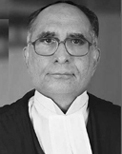S. H. Kapadia facts for kids
Quick facts for kids
Sarosh Homi Kapadia
|
|
|---|---|

Justice Sarosh Homi Kapadia
|
|
| 38th Chief Justice of India | |
| In office 12 May 2010 – 28 September 2012 |
|
| Appointed by | Pratibha Patil |
| Preceded by | K. G. Balakrishnan |
| Succeeded by | Altamas Kabir |
| 2nd Chief Justice of Uttarakhand | |
| In office 5 August 2003 – 17 December 2003 |
|
| Preceded by | Prakash Chandra Verma (acting) |
| Succeeded by | Prakash Chandra Verma (acting) |
| Personal details | |
| Born | 29 September 1947 Mumbai, India |
| Died | 4 January 2016 (aged 68) Mumbai, India |
| Spouse | Shahnaz Kapadia |
Sarosh Homi Kapadia (born September 29, 1947 – died January 4, 2016) was a very important judge in India. He served as the 38th Chief Justice of India. He was also the first Chief Justice of India who was born after India became independent in 1947.
Contents
Journey to Becoming a Judge
Sarosh Homi Kapadia was born in Mumbai in 1947. He studied law at Government Law College, Mumbai. This college is known as the oldest law school in Asia.
Kapadia started his working life in a very humble way. He began as a low-level employee. Later, he worked as a law clerk in a lawyer's office in Mumbai. He even worked for a famous lawyer named Feroze Damania. On September 10, 1974, he became an advocate, which means he could argue cases in the Bombay High Court.
Rising Through the Ranks
Kapadia became a judge of the Bombay High Court on October 8, 1991. He was made a permanent judge on March 23, 1993. On August 5, 2003, he became the Chief Justice of the Uttarakhand High Court.
Just a few months later, on December 18, 2003, he was appointed as a judge of the Supreme Court of India. This is the highest court in India.
Chief Justice of India
On May 12, 2010, Sarosh Homi Kapadia reached the highest position in the Indian legal system. President Pratibha Patil swore him in as the Chief Justice of India. He held this important role until he retired on September 29, 2012.
While he was Chief Justice, he also led the General Council of the Gujarat National Law University. He was also a Visitor of the National Law School of India University.
About His Life
Kapadia was married to Shahnaz. They had a son, who became a chartered accountant, and a daughter.
He was a very religious person and followed the Zoroastrian faith. Besides law, he was also very interested in other subjects. These included economics, how public money is managed, and even theoretical physics. He also studied Hindu and Buddhist philosophies.
Sarosh Homi Kapadia passed away on January 4, 2016, in Mumbai.
Important Decisions
Justice Kapadia made many important decisions during his time as a judge. These decisions helped shape the law in India.
Key Judgments
- He was part of a major decision about the appointment of a top government official. The court said the appointment was not done correctly.
- He gave a different opinion in a case involving a well-known politician, Lalu Prasad Yadav. This showed his independent thinking.
- He was also involved in the famous Vodafone judgment. This was a very high-profile case about taxes.
- In 2005, he made an important decision about how property is passed down in families. He ruled against using DNA tests in such cases.
Inspiring Words
Justice Kapadia often shared his thoughts on justice and India.
- "I am proud to be an Indian. India is the only country where a member of the minority Parsi community with a population of 1,67,000, like myself, can aspire to attain the post of the Chief Justice of India. These things do not happen in our neighbouring countries."
- He said this during Independence Day celebrations at the Supreme Court. It shows his pride in India's fairness.
- "I come from a poor family. I started my career as a class IV employee and the only asset I possess is integrity."
- These words highlight his humble beginnings and his strong belief in honesty.
- "A day might come when the rule of law will stand reduced to a rope of sand."
- He said this when many public interest cases were being filed. He was worried about the legal system becoming weak.


